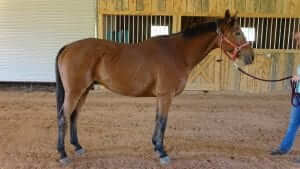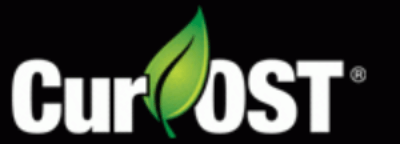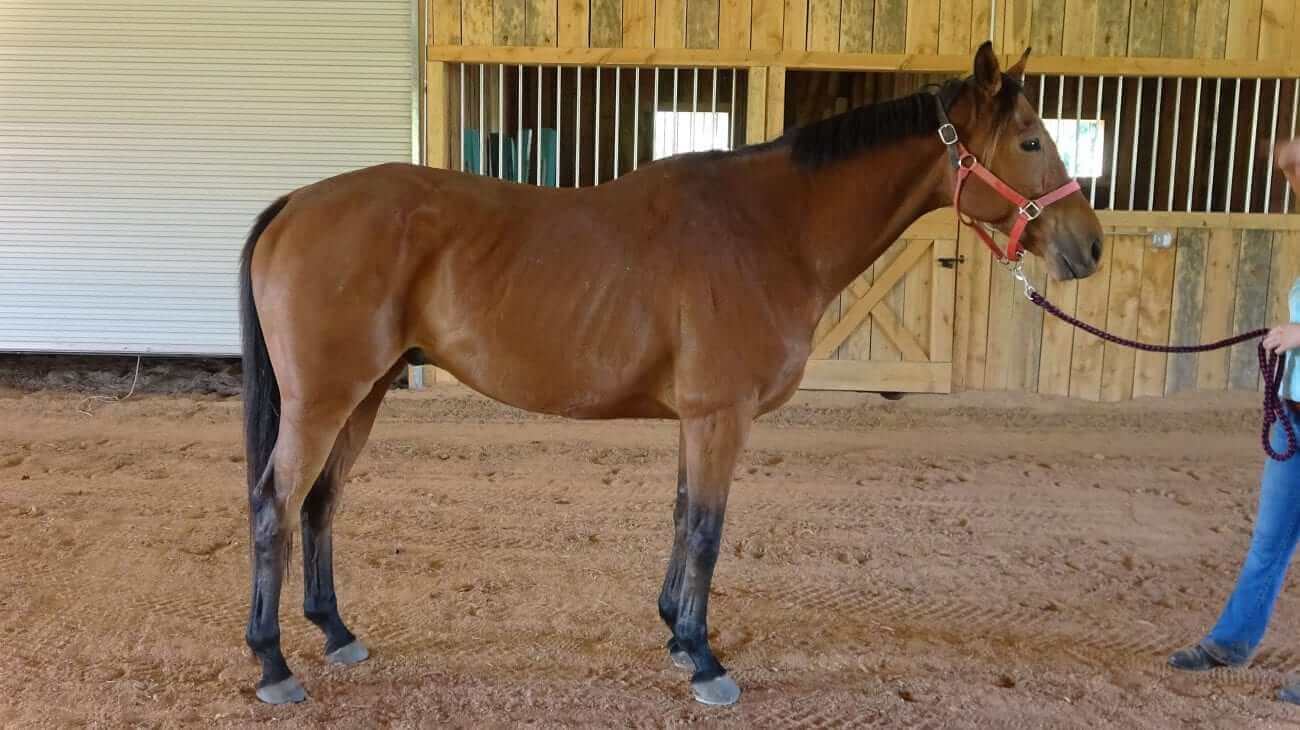Topline and cold back problems are common in the equine industry. In many cases, the problem is more cosmetic in the horse, i.e., loss of muscle tone to the topline or lumbar region. While in others, the problems extend into performance related issues, such as overt pain or failure to fully perform or stretch out. Although there are no specific remedies to these issues, some approaches have proven more valuable at least in our experience with rehabilitation patients.

The topline is the grouping of dorsal musculature to the thoracic and lumbar region. This area is composed of several large muscle groups that run parallel to the spine, coursing up and down the back on either side. Muscle being muscles, when there is loss of the topline, there are a few things to keep in mind as to potential causes or contributors. This is not much different than in humans, but we tend to not apply similar concepts or ideas.
Contributors to Topline Loss in the Horse
There are several contributors to loss of the topline in the horse, but the most common in my experience include:
- Dietary related contributors (low or incomplete protein source most often)
- Training related (improper engagement of the back muscles sufficient for development)
- Neurological related causes (EPM, EHV, or otherwise)
- Cold Back Syndrome or compromised blood circulation
- Primary inflammation in other region that impairs ability to engage and develop back
Dietary Intervention for Topline Concerns
In many cases, most owners attempt to manage a topline concern with dietary changes with an increased fat or grain load in the diet. For most, the main goal here is to create padding in the thoracic and lumbar region, which is okay, but may not be directly improving the musculature. The topline is ideally composed of muscle, which supports the spine. Through increased fat and grain intake, in most cases you are adding more fat to the body, depositing it in the back and other regions. If you are looking for a cosmetic fill to the region, this route may prove helpful, but there are a few things to keep in mind.
First, adding high fat to the diet will add weight to the horse, not just in the topline but the entire body. If the horse is in need of weight gain overall, this may prove helpful, but if the horse is an easy keeper type the added fat may contribute to more health problems on an inflammatory level. This is true regardless of the type of fat chosen.
Second, increasing grain volume to these horses is along the same lines. Essentially one is adding calories which can add weight over time. However, with excessive grains you likely also have excessive carbohydrate intake in a short period of time which can alter microbial populations in the hindgut and then contribute to other health related conditions. This is likely not the best option in any horse due to the potential negative ramifications of excessive grain intake in the horse. High carbohydrate intake can further complicate GI related issues and negatively impact inflammatory status and digestion. This is commonly seen in cases of leaky gut syndrome.
In most cases of dietary related topline issues, the protein source and therefore the overall nutrient value of the forage fed is not ideal for the horse in question. Solutions are often found when you move to a higher quality protein forage such as alfalfa, Timothy or Orchard grass hay. Most grass hays and even Bermuda can have lower levels of overall protein and likewise lower overall nutrient quality. Making a move to a higher quality forage can provide amino acids in a more complete fashion along with the natural nutrients to add in cellular health and recovery. One has to keep in mind that with a horse in active training or competition, that caloric needs are increased. A baseline is 2% of BW per day, but this level may increase based on the needs of the horse.
If we have a horse in rehab that is on a high quality diet but still desires more protein and support for muscle development, the main formula that we will include in the regimen is the Cur-OST EQ Nourish formula. This product helps to provide additional balanced plant based protein in a concentrated form, along with higher levels of amino acids for cellular and digestive health. The EQ Nourish also contains CoEnzyme 10 and Alpha Lipoic Acid which aid in cellular energy and overall function.
One last notation on diet and nutrition is to evaluate these horses for intestinal parasites, especially if overall body condition is lacking.
Training and Impact on the Topline in the Horse
If you look at humans with back related problems, one primary means of better management is to build those muscle groups. Of course, nutrition plays a major role in muscle development, so this does need to be addressed. However, even with the best nutrition program, a muscle will not develop properly unless it is stimulated and challenged. A muscle develops over time due to being stressed, adapting, then responding and being further challenged. Genetics do play a role, but proper training and nutrition can also aid in overcoming some obstacles.
I am not a trainer, but can say that in my experience many owners are not using a proper training program. The horses are ridden the same way every time with no mixing up of the program, no variety. There are specific exercises that you can do to stimulate and challenge the back muscles, which can be found online. Other exercises that we have found useful include use of ground poles, lower level jumps even in non-jumper horses, and hill work. There are numerous means of stimulating the back muscles. I believe the key is variety and continual challenging to aid in their development. I think the key point here is not to just rely on nutrition, but realize that the muscles need to be challenged for growth to occur.
Neurological Involvement in Topline Concerns in the Horse
The topline is a grouping of muscles. They are dependent on proper nutrition, proper stimulation and also proper circulation and neurological input to develop. It is not extremely common to have neurological issues of concern in topline problems in the horse, but they certainly do happen. Conditions such as EPM, EHV, and non-neurological conditions including PSSM can all impact muscle development. It is important when evaluating these horses to keep these conditions in mind, ruling them in or out with a simple neurological evaluation or further testing if indicated.
Cold Back Syndrome and Topline Concerns in the Horse
Cold back syndrome is a name that I have coined and use intermittently with owners. In these cases, the back is perceived as being cold in nature, demonstrating some pain at times, but more so overall weakness and failure to develop. The musculature of the back is generally not painful to the touch, but just underdeveloped and as a result, the horse fails to engage properly and perform. In many of these cases, the back is more cold in nature due to decreased overall blood circulation.
In the world of Chinese medicine, there are two terms used quite commonly: Yin and Yang. In most cases, these two terms are assigned to the kidneys but can be involved with any organ. The Yin component is perceived as being cool and moist, while the Yang is the opposite being more warm and dry. Ideally, you desire a balance between the two. The kidneys in Chinese medicine are involved with vitality and contain within them the energy to keep the body going on certain levels. With advancing age and also excessive work or stress, the kidneys can become depleted of their energy. Interestingly, the kidneys are involved with most back conditions, both in man and animals. When the kidneys become depleted or drained, again due to age or excessive work/stress, the back can be impacted. This drain can come in the form of Yin, Yang, or both being depleted. If Yang is more depleted, this contributes to the cold back syndrome and is more common in my experience in the equine athlete that has had little rest or is overall depleted energy wise.
Herbs and diet can help in this condition. In many OTTB’s that I have worked with and experience cold back syndrome, they have been overworked on the track and have been contending with one injury after the other. Often, their topline desires development, but they are also lower in overall energy, often dragging at times. Almost like a person that has just had enough of life, that they are at the point of being physically exhausted. Dietary change do help as does a change in the exercise program, but I have found that supplementation with specific herbs can be of great value.
Two herbs that we commonly use are Cordyceps sinensis and Astragalus membranaceus. Both of these herbs target the kidney in their function but also the lungs. Cordyceps is more of a kidney tonic, slightly warm in nature, tonifying kidney Yang predominantly. Astragalus is also a kidney tonic, but stimulates the production of energy in the body and also benefits digestion. These two herbs can be immensely helpful in recovering a depleted equine athlete and also aiding in restoration of the topine. As you tonify the kidneys and recover energy, the body feels better, circulation is improved, digestion is enhanced and nutrients are put to work. These two herbs are found in the Cur-OST EQ Revive formula and used extensively in our rehab program. They do aid in energy production, so not ideal for a hyper or ‘hot’ natured horse, as this could be counterproductive.
Inflammation, Lameness and Topline Concerns in the Horse
The back is not an isolated system of muscles, but is dependent on many other muscle groups to allow it to do its job completely. In some cases of back soreness or topline concerns, the back is simply not engaged enough to allow stimulation and development. This can be due to an incomplete training program, but it can also be due to a primary lameness in another area of the body. In most of these cases, the horse has concurrent rear limb pain associated with an inflammatory joint condition, tendon injury, or a sore foot. If your horse is sore in their hocks, tendon or even their foot and is not willing to move forward and engage a back, problems may become evident due to lack of development. In these cases, the back is not the primary issue, although cosmetically or physically it may appear so. The solution for better management comes in addressing the primary source of pain, then the back will soon follow along. Inflammation can be a major factor in many back complaints in the horse, but is often overlooked as a contributor.
Along these lines, two other contributors to topline concerns in the inflammatory department are improper saddle fit and improper foot trimming and/or balance. Both of these factors can create pain and impingement to the horse, resulting in failure to fully engage the back.
The important thing with topline issues in the horse is to see the big picture, see the ‘whole horse’. In most cases, the owners simply see a lack of topline in their horse, which may or may not be a primary problem. If you just jump to dietary intervention by increased fat or grain intake, you may potentially create more problems internally, while the primary problem goes unmanaged. There are many contributors to the lack of topline development in the horse and in many cases, several of these factors are in play. Through better recognition of the problems at hand, targeted intervention can be developed to intervene on the correct levels.
At Nouvelle Research, Inc. we are here to assist you. These cases can be complex at times, but solutions for better management are available.
Author: Tom Schell, D.V.M., CVCH, CHN



My little , elderly, mini donkey lost his top line several years ago. Nothing in his diet or care has changed. He just got a little older, now 25, He has access to pasture, coastal hay in slow feeder hay net, salt, and water 24/7 and is fed Standlee Timothy Grass pellets at least twice per day …and more if he asks for more. Yes, I do understand some donkey talk but sadly not all. His coat is good, His hooves are good. He seems to have good energy. He has a big belly but reduced topline.
His buddy on the other hand who is now 20 has taken a turn in the opposite direction. He is just too pudgy and I do not know how to get the weight off of him when the two cannot be separated….not even for a minute. He has access to the hay, pasture, salt, and water but gets very limited amount of Timothy pellets….1/2 c in morning and evening.
Any suggestions as to how to get weight on the topline on the older donkey ?